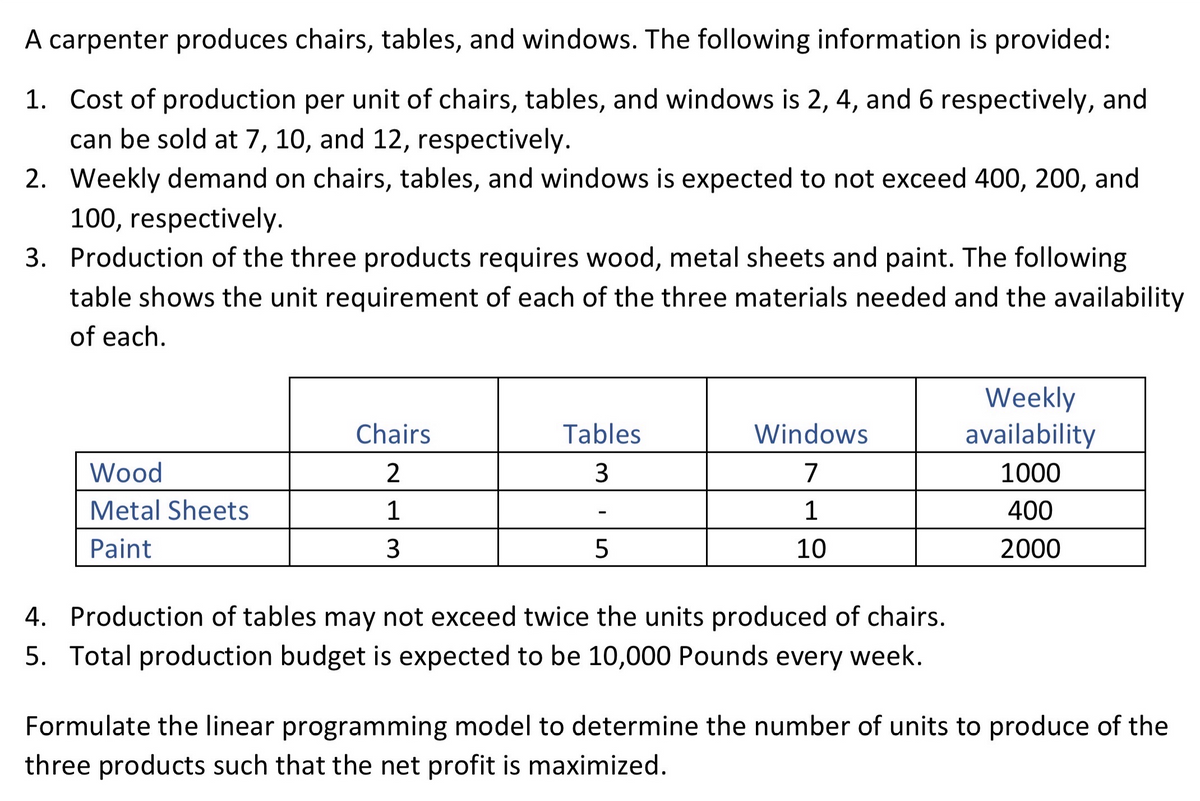A carpenter produces chairs, tables, and windows. The following information is provided: 1. Cost of production per unit of chairs, tables, and windows is 2, 4, and 6 respectively, and can be sold at 7, 10, and 12, respectively. 2. Weekly demand on chairs, tables, and windows is expected to not exceed 400, 200, and 100, respectively. 3. Production of the three products requires wood, metal sheets and paint. The following table shows the unit requirement of each of the three materials needed and the availability of each. Weekly Chairs Tables Windows availability Wood 2 3 7 1000 Metal Sheets 1 1 400 - Paint 3 10 2000 4. Production of tables may not exceed twice the units produced of chairs. 5. Total production budget is expected to be 10,000 Pounds every week. Formulate the linear programming model to determine the number of units to produce of the three products such that the net profit is maximized.
A carpenter produces chairs, tables, and windows. The following information is provided: 1. Cost of production per unit of chairs, tables, and windows is 2, 4, and 6 respectively, and can be sold at 7, 10, and 12, respectively. 2. Weekly demand on chairs, tables, and windows is expected to not exceed 400, 200, and 100, respectively. 3. Production of the three products requires wood, metal sheets and paint. The following table shows the unit requirement of each of the three materials needed and the availability of each. Weekly Chairs Tables Windows availability Wood 2 3 7 1000 Metal Sheets 1 1 400 - Paint 3 10 2000 4. Production of tables may not exceed twice the units produced of chairs. 5. Total production budget is expected to be 10,000 Pounds every week. Formulate the linear programming model to determine the number of units to produce of the three products such that the net profit is maximized.
Linear Algebra: A Modern Introduction
4th Edition
ISBN:9781285463247
Author:David Poole
Publisher:David Poole
Chapter2: Systems Of Linear Equations
Section2.4: Applications
Problem 27EQ
Related questions
Question
Formulation
Problem
2
Assignments
initial
Construct
the
tableaux
plus
one
simplex

Transcribed Image Text:A carpenter produces chairs, tables, and windows. The following information is provided:
1. Cost of production per unit of chairs, tables, and windows is 2, 4, and 6 respectively, and
can be sold at 7, 10, and 12, respectively.
2. Weekly demand on chairs, tables, and windows is expected to not exceed 400, 200, and
100, respectively.
3. Production of the three products requires wood, metal sheets and paint. The following
table shows the unit requirement of each of the three materials needed and the availability
of each.
Weekly
Chairs
Tables
Windows
availability
Wood
2
3
7
1000
Metal Sheets
1
1
400
Paint
10
2000
4. Production of tables may not exceed twice the units produced of chairs.
5. Total production budget is expected to be 10,000 Pounds every week.
Formulate the linear programming model to determine the number of units to produce of the
three products such that the net profit is maximized.
Expert Solution
This question has been solved!
Explore an expertly crafted, step-by-step solution for a thorough understanding of key concepts.
This is a popular solution!
Trending now
This is a popular solution!
Step by step
Solved in 3 steps with 3 images

Knowledge Booster
Learn more about
Need a deep-dive on the concept behind this application? Look no further. Learn more about this topic, advanced-math and related others by exploring similar questions and additional content below.Recommended textbooks for you

Linear Algebra: A Modern Introduction
Algebra
ISBN:
9781285463247
Author:
David Poole
Publisher:
Cengage Learning

Algebra for College Students
Algebra
ISBN:
9781285195780
Author:
Jerome E. Kaufmann, Karen L. Schwitters
Publisher:
Cengage Learning

Linear Algebra: A Modern Introduction
Algebra
ISBN:
9781285463247
Author:
David Poole
Publisher:
Cengage Learning

Algebra for College Students
Algebra
ISBN:
9781285195780
Author:
Jerome E. Kaufmann, Karen L. Schwitters
Publisher:
Cengage Learning